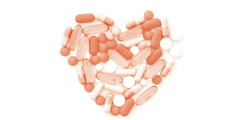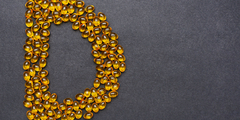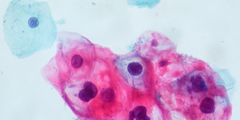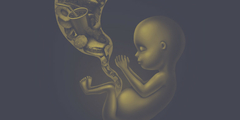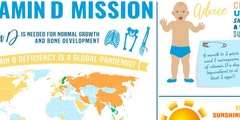
Nu hiv een behandelbare ziekte is geworden, lijkt aandacht voor voeding bijna een luxeverschijnsel. Sinds de komst van de Highly Active Antiretroviral Therapy (HAART) rond 1996 is optimisme logischerwijs de boventoon gaan voeren. Tekorten aan essentiële voedingsstoffen blijken echter nog steeds voor te komen en ook frequenter dan onder het gemiddelde van de bevolking. Bovendien zijn velen met hiv ook nu nog verstoken van medicijnen en kan voor hen voedingstherapie van levensbelang zijn. Tot op heden is er onder dokters weinig aandacht voor terwijl wetenschappelijk onderzoek het belang ervan aantoont.
Beste bezoeker, u heeft geen toegang.
Enkel (web)abonnees hebben toegang tot tijdschriftartikelen. Het webabonnement is nog in de maak.
U kunt zich wel alvast (gratis) registreren en tal van andere webartikelen raadplegen!
Auteur
Verschenen in
Referenties
1 Beach RS, Mantero-Atienza E, Shor-Posner G, Javier JJ, Szapocznik J, Morgan R, Sauberlich HE, Cornwell PE, Eisdorfer C, Baum MK. Specific nutrient abnormalities in asymptomatic HIV-1 infection. AIDS. 1992 Jul;6(7):701-8. https://www.ncbi.nlm.nih.gov/pubmed/1503689
2 Abrams B, Duncan D, Hertz-Picciotto I. A prospective study of dietary intake and acquired immune deficiency syndrome in HIV-seropositive homosexual men. J Acquir Immune Defic Syndr. 1993 Aug;6(8):949-58. https://www.ncbi.nlm.nih.gov/pubmed/8100273
3 Drain PK, Kupka R, Mugusi F, Fawzi WW. Micronutrients in HIV-positive persons receiving highly active antiretroviral therapy. Am J Clin Nutr. 2007 Feb;85(2):333-45. Review. https://academic.oup.com/ajcn/article/85/2/333/4649551
4 Shivakoti R, Christian P, Yang WT, Gupte N, Mwelase N, Kanyama C, Pillay S, Samaneka W, Santos B, Poongulali S, Tripathy S, Riviere C, Berendes S, Lama JR, Cardoso SW, Sugandhavesa P, Tang AM, Semba RD, Campbell TB, Gupta A; NWCS 319 and PEARLS Study Team. Prevalence and risk factors of micronutrient deficiencies pre- and post-antiretroviral therapy (ART) among a diverse multicountry cohort of HIV-infected adults. Clin Nutr. 2016 Feb;35(1):183-9. https://www.ncbi.nlm.nih.gov/pmc/articles/PMC4531105
5 Pinzone MR, Di Rosa M, Malaguarnera M, Madeddu G, Focà E, Ceccarelli G, d'Ettorre G, Vullo V, Fisichella R, Cacopardo B, Nunnari G. Vitamin D deficiency in HIV infection: an underestimated and undertreated epidemic. Eur Rev Med Pharmacol Sci. 2013 May;17(9):1218-32. Review. https://www.europeanreview.org/article/4071
6 DAD Study Group, Friis-Møller N, Reiss P, Sabin CA, Weber R, Monforte Ad, El-Sadr W, Thiébaut R, De Wit S, Kirk O, Fontas E, Law MG, Phillips A, Lundgren JD. Class of antiretroviral drugs and the risk of myocardial infarction. N Engl J Med. 2007 Apr 26;356(17):1723-35. https://www.nejm.org/doi/full/10.1056/nejmoa062744
7 Merenstein D, Wang C, Gandhi M, Robison E, Levine AM, Schwartz RM, Weber KM, Liu C. An investigation of the possible interaction between the use of Vitamin C and highly active antiretroviral therapy (HAART) adherence and effectiveness in treated HIV+ women. Complement Ther Med. 2012 Aug;20(4):222-7. https://www.ncbi.nlm.nih.gov/pmc/articles/PMC3351689
8 Mueller NJ, Fux CA, Ledergerber B, Elzi L, Schmid P, Dang T, Magenta L, Calmy A, Vergopoulos A, Bischoff-Ferrari HA, Swiss HIVCS. High prevalence of severe vitamin D deficiency in combined antiretroviral therapy-naive and successfully treated Swiss HIV patients. AIDS. 2010;24:1127–1134. https://www.ncbi.nlm.nih.gov/pubmed/20168200; Sherwood JE, Mesner OC, Weintrob AC, Hadigan CM, Wilkins 9 KJ, Crum-Cianflone NF, Aronson NE. Vitamin D deficiency and its association with low bone mineral density, HIV-related factors, hospitalization, and death in a predominantly black HIV-infected cohort. Clin Infect Dis. 2012;55:1727–1736. https://www.ncbi.nlm.nih.gov/pmc/articles/PMC3501334
9 Poiana C, Capatina C, Cercel AS, Sandulescu O, Streinu Cercel A. Hypovitaminosis D in hiv-infected patients. Acta Endocrinol (Buchar). 2019 Jan-Mar;-5(1):102-106. https://www.ncbi.nlm.nih.gov/pmc/articles/PMC6535333
10 Van Den Bout-Van Den Beukel CJ, Fievez L, Michels M, Sweep FC, Hermus AR, Bosch ME, Burger DM, Bravenboer B, Koopmans PP, Van Der Ven AJ. Vitamin D deficiency among HIV type 1-infected individuals in the Netherlands: effects of antiretroviral therapy. AIDS Res Hum Retroviruses. 2008;24:1375–1382. https://www.ncbi.nlm.nih.gov/pubmed/18928396
11 Chisati EM, Constantinou D, Lampiao F. Management of Reduced Bone Mineral Density in HIV: Pharmacological Challenges and the Role of Exercise. Front Physiol. 2018 Aug 7;9:1074. https://www.ncbi.nlm.nih.gov/pmc/articles/PMC6090029
12 Triant VA, Brown TT, Lee H, Grinspoon SK. Fracture prevalence among human immunodeficiency virus (HIV)-infected versus non-HIV-infected patients in a large U.S. healthcare system. J Clin Endocrinol Metab. 2008 Sep;93(9):3499-504. https://www.ncbi.nlm.nih.gov/pmc/articles/PMC2567857; Torti C, Mazziotti G, Soldini PA, Focà E, Maroldi R, Gotti D, Carosi G, Giustina A. High prevalence of radiological vertebral fractures in HIV-infected males. Endocrine. 2012 Jun;41(3):512-7. https://www.ncbi.nlm.nih.gov/pubmed/22198528
13 Brown TT, Qaqish RB. Antiretroviral therapy and the prevalence of osteopenia and osteoporosis: a meta-analytic review. AIDS. 2006 Nov 14;20(17):2165-74.
https://www.ncbi.nlm.nih.gov/pubmed/17086056
14 Tebas P, Powderly WG, Claxton S, Marin D, Tantisiriwat W, Teitelbaum SL, Yarasheski KE. Accelerated bone mineral loss in HIV-infected patients receiving potent antiretroviral therapy. AIDS. 2000 Mar 10;14(4):F63-7. https://www.ncbi.nlm.nih.gov/pmc/articles/PMC3170993; Calmy A, Fux CA, Norris R, Vallier N, Delhumeau C, Samaras K, Hesse K, Hirschel B, Cooper DA, Carr A. Low bone mineral density, renal dysfunction, and fracture risk in HIV infection: a cross-sectional study. J Infect Dis. 2009 Dec 1;200(11):1746-54. https://academic.oup.com/jid/article/200/11/1746/833219; Chiţu-Tișu CE, Barbu EC, Lazăr M, Ion DA, Bădărău IA. Low bone mineral density and associated risk factors in HIV-infected patients. Germs. 2016 Jun 1;6(2):50-9. https://www.ncbi.nlm.nih.gov/pmc/articles/PMC4956161
15 Currier JS, Taylor A, Boyd F, Dezii CM, Kawabata H, Burtcel B, Maa JF, Hodder S. Coronary heart disease in HIV-infected individuals. J Acquir Immune Defic Syndr. 2003 Aug 1;33(4):506-12. https://www.ncbi.nlm.nih.gov/pubmed/12869840; Triant VA, Lee H, Hadigan C, Grinspoon SK. Increased acute myocardial infarction rates and cardiovascular risk factors among patients with human immunodeficiency virus disease. J Clin Endocrinol Metab. 2007 Jul;92(7):2506-12. https://www.ncbi.nlm.nih.gov/pmc/articles/PMC2763385
16 Grunfeld C, Delaney JA, Wanke C, Currier JS, Scherzer R, Biggs ML, Tien PC, Shlipak MG, Sidney S, Polak JF, O'Leary D, Bacchetti P, Kronmal RA. Preclinical atherosclerosis due to HIV infection: carotid intima-medial thickness measurements from the FRAM study. AIDS. 2009 Sep 10;23(14):1841-9. https://www.ncbi.nlm.nih.gov/pmc/articles/PMC3156613; Hsue PY, Hunt PW, Schnell A, Kalapus SC, Hoh R, Ganz P, Martin JN, Deeks SG. Role of viral replication, antiretroviral therapy, and immunodeficiency in HIV-associated atherosclerosis. AIDS. 2009 Jun 1;23(9):1059-67. https://www.ncbi.nlm.nih.gov/pmc/articles/PMC2691772; Choi AI, Lo JC, Mulligan K, Schnell A, Kalapus SC, Li Y, Hunt PW, Martin JN, Deeks SG, Hsue PY. Association of vitamin D insufficiency with carotid intima-media thickness in HIV-infected persons. Clin Infect Dis. 2011 Apr 1;52(7):941-4. https://www.ncbi.nlm.nih.gov/pmc/articles/PMC3106229
17 Brown TT, Cole SR, Li X, Kingsley LA, Palella FJ, Riddler SA, Visscher BR, Margolick JB, Dobs AS. Antiretroviral therapy and the prevalence and incidence of diabetes mellitus in the multicenter AIDS cohort study. Arch Intern Med. 2005 May 23;165(10):1179-84. https://jamanetwork.com/journals/jamainternalmedicine/fullarticle/486570; Szep Z, Guaraldi G, Shah SS, Lo Re V 3rd, Ratcliffe SJ, Orlando G, Carli F, Rossi R, Rochira V, Tebas P. Vitamin D deficiency is associated with type 2 diabetes mellitus in HIV infection. AIDS. 2011 Feb 20;25(4):525-9. https://www.ncbi.nlm.nih.gov/pmc/articles/PMC3366629
18 Han J, Guo X, Yu X, Liu S, Cui X, Zhang B, Liang H. 25-Hydroxyvitamin D and Total Cancer Incidence and Mortality: A Meta-Analysis of Prospective Cohort Studies. Nutrients. 2019 Sep 26;11(10). https://www.mdpi.com/2072-6643/11/10/2295/htm
19 Tin A, Zhang L, Estrella MM, Hoofnagle A, Rebholz CM, Brown TT, Palella FJ Jr, Witt MD, Jacobson LP, Kingsley LA, Abraham AG. Vitamin D Status and Kidney Function Decline in HIV-Infected Men: A Longitudinal Study in the Multicenter AIDS Cohort Study. AIDS Res Hum Retroviruses. 2017 Nov;33(11):1140-1148. https://www.ncbi.nlm.nih.gov/pmc/articles/PMC5665498
20 Vergori A, Pinnetti C, Lorenzini P, Brita A, Libertone R, Mastrorosa I, Cicalini S, Antinori A, Ammassari A. Vitamin D deficiency is associated with neurocognitive impairment in HIV-infected subjects. Infection. 2019 Jun 10. https://www.ncbi.nlm.nih.gov/pubmed/31183805;
21 Alvarez N, Aguilar-Jimenez W, Rugeles MT. The Potential Protective Role of Vitamin D Supplementation on HIV-1 Infection. Front Immunol. 2019 Sep 25;10:2291. https://www.ncbi.nlm.nih.gov/pmc/articles/PMC6773828; Teixeira NDSCCA, Pereira BM, Oliveira IKF, Lima CHR, Carvalho CMRG, Nunes IFOC, Costa DL, Paiva AA. Effect of vitamin D3 supplementation on HIV-infected adults: a systematic reviewVitamin Dӡ Supplementation on HIV-Infected Adults: A Systematic Review. Nutr Hosp. 2019 Oct 17;36(5):1205-1212. https://www.ncbi.nlm.nih.gov/pubmed/31526009
22 Paccou J, Viget N, Legrout-Gérot I, Yazdanpanah Y, Cortet B. Bone loss in patients with HIV infection. Joint Bone Spine. 2009 Dec;76(6):637-41. https://www.ncbi.nlm.nih.gov/pubmed/19945322; Faber J, Bech A, van Bentum P, Gisolf J, Hassing RJ, de Boer H. Long-term impact of Calcium and Vitamin D supplementation on Bone Density in HIV+ Patients with documented deficiencies. AIDS Res Hum Retroviruses. 2019 Sep 16. https://www.ncbi.nlm.nih.gov/pubmed/31523978
23 Tang AM, Graham NM, Saah AJ. Effects of micronutrient intake on survival in human immunodeficiency virus type 1 infection. Am J Epidemiol. 1996 Jun 15;143(12):1244-56. https://www.ncbi.nlm.nih.gov/pubmed/8651223
24 Tang AM, Graham NM, Kirby AJ, McCall LD, Willett WC, Saah AJ. Dietary micronutrient intake and risk of progression to acquired immunodeficiency syndrome (AIDS) in human immunodeficiency virus type 1 (HIV-1)-infected homosexual men. Am J Epidemiol. 1993 Dec 1;138(11):937-51. https://www.ncbi.nlm.nih.gov/pubmed/7903021
25 Hepburn MJ, Dyal K, Runser LA, Barfield RL, Hepburn LM, Fraser SL. Low serum vitamin B12 levels in an outpatient HIV-infected population. Int J STD AIDS. 2004 Feb;15(2):127-33. https://www.ncbi.nlm.nih.gov/pubmed/15006076
26 Tang AM, Graham NM, Chandra RK, Saah AJ. Low serum vitamin B-12 concentrations are associated with faster human immunodeficiency virus type 1 (HIV-1) disease progression. J Nutr. 1997 Feb;127(2):345-51. https://www.ncbi.nlm.nih.gov/pubmed/9039838; James JS. Low vitamin B-12 blood levels associated with faster progression to AIDS. AIDS Treat News. 1997 Feb 7;(No 264):3-4. https://www.ncbi.nlm.nih.gov/pubmed/11364102
27 Remacha AF, Cadafalch J, Sardà P, Barceló M, Fuster M. Vitamin B-12 metabolism in HIV-infected patients in the age of highly active antiretroviral therapy: role of homocysteine in assessing vitamin B-12 status. Am J Clin Nutr. 2003 Feb;77(2):420-4. https://www.ncbi.nlm.nih.gov/pubmed/12540403
28 Falasca K, Di Nicola M, Di Martino G, Ucciferri C, Vignale F, Occhionero A, Vecchiet J. The impact of homocysteine, B(12), and D vitamins levels on functional neurocognitive performance in HIV-positive subjects. BMC Infect Dis. 2019 Feb 4;19(1):105. https://www.ncbi.nlm.nih.gov/pmc/articles/PMC6360746
29 Grigoletti SS, Guindani G, Moraes RS, Ribeiro JP, Sprinz E. Short-term folinic acid supplementation improves vascular reactivity in HIV-infected individuals: a randomized trial. Nutrition. 2013 Jun;29(6):886-91.
https://www.ncbi.nlm.nih.gov/pubmed/23660169
30 Poudel-Tandukar K, Chandyo RK. Dietary B Vitamins and Serum C-Reactive Protein in Persons With Human Immunodeficiency Virus Infection: The Positive Living With HIV (POLH) Study. Food Nutr Bull. 2016 Dec;37(4):517-528. https://www.ncbi.nlm.nih.gov/pubmed/27370977
31 Schramm C, Wanitschke R, Galle PR. Thiamine for the treatment of nucleoside analogue-induced severe lactic acidosis. Eur J Anaesthesiol. 1999 Oct;16(10):733-5. https://www.ncbi.nlm.nih.gov/pubmed/10583359
32 Pedrol E, Ribell M, Deig E, Villà Mdel C, Miró O, Garrabou G, Soler A. Treatment of symptomatic hyperlactatemia and lactic acidosis in HIV+ patients under nucleoside reverse transcriptase inhibitors. Med Clin (Barc). 2005 Jul 9;125(6):201-4. https://www.ncbi.nlm.nih.gov/pubmed/16022831
33 Posteraro AF 3rd, Mauriello M, Winter SM. Riboflavin treatment of antiretroviral induced lactic acidosis and hepatic steatosis. Conn Med. 2001 Jul;65(7):387-90. https://www.ncbi.nlm.nih.gov/pubmed/11508132; Bowers JM, Bert-Moreno A. Treatment of HAART-induced lactic acidosis with B vitamin supplements. Nutr Clin Pract. 2004 Aug;19(4):375-8. https://www.ncbi.nlm.nih.gov/pubmed/16215128
34 Butterworth RF, Gaudreau C, Vincelette J, et al. Thiamine deficiency and Wernicke’s encephalopathy in AIDS. Metab Brain Dis 1991;6:207-212. https://www.ncbi.nlm.nih.gov/pubmed/1812394
35 Le Berre AP, Fama R, Sassoon SA, Pfefferbaum A, Sullivan EV, Zahr NM. Cognitive and Motor Impairment Severity Related to Signs of Subclinical Wernicke's Encephalopathy in HIV Infection. J Acquir Immune Defic Syndr. 2019 Jul 1;81(3):345-354. https://www.ncbi.nlm.nih.gov/pubmed/30958387
36 Larsen TR, Dragu D, Williams M. Wernicke's Encephalopathy: An Unusual Consequence of the Acquired Immune Deficiency Syndrome-Case Report and Literature Review. Case Rep Med. 2013;2013:709474. https://www.ncbi.nlm.nih.gov/pmc/articles/PMC3722985
37 Dworkin BM. Selenium deficiency in HIV infection and the acquired immunodeficiency syndrome (AIDS); Chem Biol Interact 91(2-3):181-186, 1994. PMID 8194134. http://www.ncbi.nlm.nih.gov/pubmed/8194134
38 Baum MK, Shor-Posner G, Lai S, Zhang G, Lai H, Fletcher MA, Sauberlich H, Page JB. High risk of HIV-related mortality is associated with selenium deficiency. J Acquir Immune Defic Syndr Hum Retrovirol. 1997 Aug 15;15(5):370-4. https://www.ncbi.nlm.nih.gov/pubmed/9342257
39 Muzembo BA, Ngatu NR, Januka K, Huang HL, Nattadech C, Suzuki T, Wada K, Ikeda S. Selenium supplementation in HIV-infected individuals: A systematic review of randomized controlled trials. Clin Nutr ESPEN. 2019 Dec;34:1-7. https://www.ncbi.nlm.nih.gov/pubmed/31677697
40 de Menezes Barbosa EG, Júnior FB, Machado AA, Navarro AM. A longer time of exposure to antiretroviral therapy improves selenium levels. Clin Nutr. 2015 Apr;34(2):248-51. https://www.ncbi.nlm.nih.gov/pubmed/24746975
41 Baum MK, Campa A, Lai S, Sales Martinez S, Tsalaile L, Burns P, Farahani M, Li Y, van Widenfelt E, Page JB, Bussmann H, Fawzi WW, Moyo S, Makhema J, Thior I, Essex M, Marlink R. Effect of micronutrient supplementation on disease progression in asymptomatic, antiretroviral-naive, HIV-infected adults in Botswana: a randomized clinical trial. JAMA. 2013 Nov 27;310(20):2154-63. https://www.ncbi.nlm.nih.gov/pmc/articles/PMC4347896
42 Beach RS, Mantero-Atienza E, Shor-Posner G, Javier JJ, Szapocznik J, Morgan R, Sauberlich HE, Cornwell PE, Eisdorfer C, Baum MK. Specific nutrient abnormalities in asymptomatic HIV-1 infection. AIDS. 1992 Jul;6(7):701-8. https://www.ncbi.nlm.nih.gov/pubmed/1503689
43 Jones CY, Tang AM, Forrester JE, Huang J, Hendricks KM, Knox TA, Spiegelman D, Semba RD, Woods MN. Micronutrient levels and HIV disease status in HIV-infected patients on highly active antiretroviral therapy in the Nutrition for Healthy Living cohort. J Acquir Immune Defic Syndr. 2006 Dec 1;43(4):475-82. https://www.ncbi.nlm.nih.gov/pubmed/17019373
44 Baum MK, Shor-Posner G, Lu Y, Rosner B, Sauberlich HE, Fletcher MA, Szapocznik J, Eisdorfer C, Buring JE, Hennekens CH. Micronutrients and HIV-1 disease progression. AIDS. 1995 Sep;9(9):1051-6. https://www.ncbi.nlm.nih.gov/pubmed/8527077
45 Baum MK, Lai S, Sales S, Page JB, Campa A. Randomized, controlled clinical trial of zinc supplementation to prevent immunological failure in HIV-infected adults. Clin Infect Dis. 2010 Jun 15;50(12):1653-60. https://www.ncbi.nlm.nih.gov/pmc/articles/PMC2874106
46 Baum MK, Campa A, Lai S, Lai H, Page JB. Zinc status in human immunodeficiency virus type 1 infection and illicit drug use. Clin Infect Dis. 2003;37 Suppl 2:S117-23. https://www.ncbi.nlm.nih.gov/pubmed/12942385
47 Graham NM, Sorensen D, Odaka N, Brookmeyer R, Chan D, Willett WC, Morris JS, Saah AJ. Relationship of serum copper and zinc levels to HIV-1 seropositivity and progression to AIDS. J Acquir Immune Defic Syndr. 1991;4(10):976-80. https://www.ncbi.nlm.nih.gov/pubmed/1890606
48 Jiménez-Expósito MJ, Bulló Bonet M, Alonso-Villaverde C, Serrano P, García-Lorda P, García-Luna PP, Masana L, Salas-Salvadó J. [Micronutrients in HIV-infection and the relationship with the inflammatory response]. Med Clin (Barc). 2002 Dec 7;119(20):765-9. http://www.ncbi.nlm.nih.gov/pubmed/12525309
49 Baum MK, Shor-Posner G, Lu Y, Rosner B, Sauberlich HE, Fletcher MA, Szapocznik J, Eisdorfer C, Buring JE, Hennekens CH. Micronutrients and HIV-1 disease progression. AIDS. 1995 Sep;9(9):1051-6. https://www.ncbi.nlm.nih.gov/pubmed/8527077
50 Kafwembe EM, Kelly P, Ngalande P. Vitamin A levels in HIV/AIDS. East Afr Med J. 2001 Sep;78(9):451-3.
http://www.ncbi.nlm.nih.gov/pubmed/11921574
51 O'Brien ME, Kupka R, Msamanga GI, Saathoff E, Hunter DJ, Fawzi WW. Anemia is an independent predictor of mortality and immunologic progression of disease among women with HIV in Tanzania. J Acquir Immune Defic Syndr. 2005 Oct 1;40(2):219-25. https://www.ncbi.nlm.nih.gov/pubmed/16186741
52 Gordeuk VR, Delanghe JR, Langlois MR, Boelaert JR. Iron status and the outcome of HIV infection: an overview. J Clin Virol. 2001 Feb;20(3):111-5. https://www.ncbi.nlm.nih.gov/pubmed/11166657
53 Hummelen R, Hemsworth J, Reid G. Micronutrients, N-acetyl cysteine, probiotics and prebiotics, a review of effectiveness in reducing HIV progression. Nutrients.2010 Jun;2(6):626-51. https://www.ncbi.nlm.nih.gov/pmc/articles/PMC3257666
54 Pacht ER, Diaz P, Clanton T, Hart J, Gadek JE. Serum vitamin E decreases in HIV-seropositive subjects over time. J Lab Clin Med. 1997 Sep;130(3):293-6. https://www.ncbi.nlm.nih.gov/pubmed/9341989
55 Tang AM, Graham NM, Semba RD, Saah AJ. Association between serum vitamin A and E levels and HIV-1 disease progression. AIDS. 1997 Apr;11(5):613-20. https://www.ncbi.nlm.nih.gov/pubmed/9108943
56 Allard JP, Aghdassi E, Chau J, Tam C, Kovacs CM, Salit IE, Walmsley SL. Effects of vitamin E and C supplementation on oxidative stress and viral load in HIV-infected subjects. AIDS. 1998 Sep 10;12(13):1653-9. https://www.ncbi.nlm.nih.gov/pubmed/9764785
57 Jordão Júnior AA, Silveira S, Figueiredo JF, Vannucchi H. Urinary excretion and plasma vitamin E levels in patients with AIDS. Nutrition. 1998 May;14(5):423-6. https://www.ncbi.nlm.nih.gov/pubmed/9614305
58 Graham SM, Baeten JM, Richardson BA, Bankson DD, Lavreys L, Ndinya-Achola JO, Mandaliya K, Overbaugh J, McClelland RS. Higher pre-infection vitamin E levels are associated with higher mortality in HIV-1-infected Kenyan women: a prospective study. BMC Infect Dis. 2007 Jun 26;7:63. https://www.ncbi.nlm.nih.gov/pmc/articles/PMC1914075
59 Itinoseki Kaio DJ, Rondó PH, Luzia LA, Souza JM, Firmino AV, Santos SS. Vitamin E concentrations in adults with HIV/AIDS on highly active antiretroviral therapy. Nutrients. 2014 Sep 15;6(9):3641-52. https://www.ncbi.nlm.nih.gov/pmc/articles/PMC4179180

